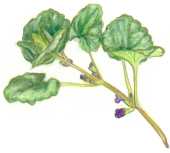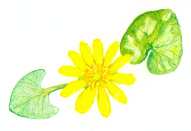
Ribwort is a perennial,
growing in so many diverse places, and in such abundance, that few people
can fail to recognize it. In lawns it will spread rapidly, choking out the
grass, and on wasteland it will colonize vast areas. The leaves grow at the
base of the plant, forming a rosette; they are long and tapering in shape,
and characterized by five (or fewer) prominent veins, or ribs, which are
what give the plant its name. Throughout the summer long stalks are sent up,
bearing the flowers, which can be of all shapes and sizes, but roughly
resemble small elongated black eggs, which when
mature are graced with a crown of conspicuous stamens (that part of the
plant which produces pollen). These splendid stamens have been likened to a
coxcomb, and from this resemblance the mature flower heads are called ‘cocks’,
and the young heads, not yet having developed stamens, ‘hens’. There is
a very excellent game which can be played with these called ‘cocks and
hens’ or ‘Kemps’, whereby one person picks a strong cock with a good
length of stem, and strikes it against another held by someone else; if both
cocks remain intact then it is the second person’s turn to strike, and the
game continues in this way with the players taking it in turn to strike,
until the flower-head of one of the stalks falls off. The person with the
entire cock has won the game, and is ready to accept a new challenge.
 The
ground ivy is a low-lying, creeping plant, spreading by runners which
take root upon contact with the soil; its stem is tough and square, its
leaves dark green, remaining on the plant all Winter. Where the leaves
join the stem a cluster of discreet purple flowers occur, and a
succession of these keeps the plant in bloom from March to June. It
poses little problem as a garden weed, as it prefers hedgerows and such other shaded places, where it will be seen
mingling with the true, or common ivy—it is from the similarity in
their foliage colour and this same like for shady spots, that has given
the ground ivy its name. Since ancient times ground ivy has been
esteemed excellent for the chest, its leaves infused in boiling water
and sweetened with a little honey proving an excellent cure for a long-standing cough. It may
also be interesting to remark, that before the 17th century, when hops
became the favourite plant for brewing beer, the leaves of ground ivy
were used for this purpose—and with great effect too, it being said
that they quite improved the flavour, as well as keeping quality of the
beer. However, ground ivy does not seem to be at all popular with animals, for pigs, horses, goats and cattle will not touch
it.
The
ground ivy is a low-lying, creeping plant, spreading by runners which
take root upon contact with the soil; its stem is tough and square, its
leaves dark green, remaining on the plant all Winter. Where the leaves
join the stem a cluster of discreet purple flowers occur, and a
succession of these keeps the plant in bloom from March to June. It
poses little problem as a garden weed, as it prefers hedgerows and such other shaded places, where it will be seen
mingling with the true, or common ivy—it is from the similarity in
their foliage colour and this same like for shady spots, that has given
the ground ivy its name. Since ancient times ground ivy has been
esteemed excellent for the chest, its leaves infused in boiling water
and sweetened with a little honey proving an excellent cure for a long-standing cough. It may
also be interesting to remark, that before the 17th century, when hops
became the favourite plant for brewing beer, the leaves of ground ivy
were used for this purpose—and with great effect too, it being said
that they quite improved the flavour, as well as keeping quality of the
beer. However, ground ivy does not seem to be at all popular with animals, for pigs, horses, goats and cattle will not touch
it.
 A
herald of spring and warmer weather, the lesser celandine flowers from
February to April, forming a thick carpet of gold where
abundant. It is found throughout Europe, Western Asia and North Africa,
and in damp spots in deciduous woods. Here the celandine exploits the
trees’ natural cycle, blooming while their branches are bare in early
spring, then dying back completely once their leaves come out and the
shade becomes dense – this shade, however, is also vital, for it kills
grass and other weeds with which the celandine could not normally
compete. For the propagation of its species the celandine has several
devices; its flowers ripen into seed heads, but fertilization is often
poor, the early months being too cold for many insects; as an
alternative method small tubers form in the leaf axils, which drop off
in early summer and grow new plants. The celandine is a perennial, and
dies back each year, but the roots continue to live and grow under the
ground. These roots are actually bulbs or tubers, which store all the
plant’s energy through winter, and are then able to push forth leaves
and flowers in early spring, when other plants are still dormant. The
tubers grow and multiply every year, this being another way in which the
celandine spreads.
A
herald of spring and warmer weather, the lesser celandine flowers from
February to April, forming a thick carpet of gold where
abundant. It is found throughout Europe, Western Asia and North Africa,
and in damp spots in deciduous woods. Here the celandine exploits the
trees’ natural cycle, blooming while their branches are bare in early
spring, then dying back completely once their leaves come out and the
shade becomes dense – this shade, however, is also vital, for it kills
grass and other weeds with which the celandine could not normally
compete. For the propagation of its species the celandine has several
devices; its flowers ripen into seed heads, but fertilization is often
poor, the early months being too cold for many insects; as an
alternative method small tubers form in the leaf axils, which drop off
in early summer and grow new plants. The celandine is a perennial, and
dies back each year, but the roots continue to live and grow under the
ground. These roots are actually bulbs or tubers, which store all the
plant’s energy through winter, and are then able to push forth leaves
and flowers in early spring, when other plants are still dormant. The
tubers grow and multiply every year, this being another way in which the
celandine spreads.